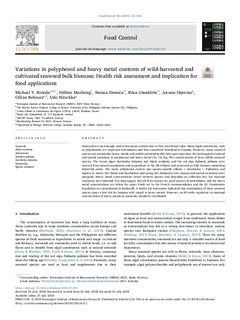| dc.contributor.author | Roleda, Michael | |
| dc.contributor.author | Marfaing, Hélène | |
| dc.contributor.author | Desnica, Natasa | |
| dc.contributor.author | Jónsdóttir, Rósa | |
| dc.contributor.author | Skjermo, Jorunn | |
| dc.contributor.author | Rebours, Celine | |
| dc.contributor.author | Nitschke, Udo | |
| dc.date.accessioned | 2018-09-18T08:19:26Z | |
| dc.date.available | 2018-09-18T08:19:26Z | |
| dc.date.created | 2018-08-30T18:17:25Z | |
| dc.date.issued | 2018-07-27 | |
| dc.identifier.citation | Food Control. 2018, 95 121-134. | nb_NO |
| dc.identifier.issn | 0956-7135 | |
| dc.identifier.uri | http://hdl.handle.net/11250/2563098 | |
| dc.description.abstract | Seaweeds are increasingly used in European cuisines due to their nutritional value. Many algal constituents, such as polyphenols, are important antioxidants and thus considered beneficial to humans. However, many seaweed species can accumulate heavy metals and exhibit potential health risks upon ingestion. We investigated temporal and spatial variations in polyphenol and heavy metal (As, Cd, Hg, Pb) concentrations of three edible seaweed species. The brown algae Saccharina latissima and Alaria esculenta, and the red alga Palmaria palmata were sourced from natural populations and aquaculture in the NE Atlantic and processed as bulk biomass mimicking industrial scales. The mean polyphenol content was species-specific (Alaria > Saccharina > Palmaria), and highest in winter (for Alaria and Saccharina) and spring (for Palmaria); inter-annual and spatial variations were marginal. Heavy metal concentrations varied between species and depended on collection site, but seasonal variations were minimal. Our data suggest that all three species are good sources of antioxidants, and the heavy metal concentrations are below the upper limits set by the French recommendation and the EU Commission Regulation on contaminants in foodstuffs. A health risk assessment indicated that consumption of these seaweed species poses a low risk for humans with regard to heavy metals. However, an EU-wide regulation on maximal concentration of heavy metals in seaweeds should be established. | nb_NO |
| dc.language.iso | eng | nb_NO |
| dc.rights | Attribution-NonCommercial-NoDerivatives 4.0 Internasjonal | * |
| dc.rights.uri | http://creativecommons.org/licenses/by-nc-nd/4.0/deed.no | * |
| dc.subject | Alaria esculenta | nb_NO |
| dc.subject | Antioxidant | nb_NO |
| dc.subject | Palmaria palmata | nb_NO |
| dc.subject | Saccharina latissima | nb_NO |
| dc.subject | Seasonality | nb_NO |
| dc.subject | Spatial variation | nb_NO |
| dc.title | Variations in polyphenol and heavy metal contents of wild-harvested and cultivated seaweed bulk biomass: Health risk assessment and implication for food applications | nb_NO |
| dc.type | Journal article | nb_NO |
| dc.type | Peer reviewed | nb_NO |
| dc.description.version | publishedVersion | nb_NO |
| dc.rights.holder | © 2018 Norwegian Institute of Bioeconomy Research. Published by Elsevier Ltd. This is an open access article under the CC BY-NC-ND license - (http://creativecommons.org/licenses/BY-NC-ND/4.0/). | nb_NO |
| dc.source.pagenumber | 121-134 | nb_NO |
| dc.source.volume | 95 | nb_NO |
| dc.source.journal | Food Control | nb_NO |
| dc.identifier.doi | 10.1016/j.foodcont.2018.07.031 | |
| dc.identifier.cristin | 1605662 | |
| dc.relation.project | Norges forskningsråd: 244244 | nb_NO |
| cristin.unitcode | 7566,6,0,0 | |
| cristin.unitname | Miljø og nye ressurser | |
| cristin.ispublished | true | |
| cristin.fulltext | original | |
| cristin.qualitycode | 1 | |

